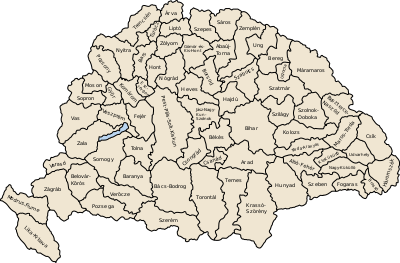Brassó County
Brassó was an administrative county (comitatus) of the Kingdom of Hungary. Its territory is now in central Romania (south-eastern Transylvania). The capital of the county was Brassó (Braşov in Romanian, Kronstadt in German).
| Brassó County | |
|---|---|
| County of the Kingdom of Hungary | |
| 1876–1920 | |
.svg.png) Coat of arms
| |
 | |
| Capital | Brassó |
| Area | |
| • Coordinates | 45°39′N 25°35′E |
• 1910 | 1,492 km2 (576 sq mi) |
| Population | |
• 1910 | 101109 |
| History | |
• Established | 1876 |
• Treaty of Trianon | June 4 1920 |
| Today part of | |
| Braşov is the current name of the capital. | |
Geography
Brassó county shared borders with Romania and the Hungarian counties Fogaras, Nagy-Küküllő and Háromszék. The river Olt formed part of its northern border. The ridge of the southern Carpathian Mountains forms its southern border. Its area was 1499 km² around 1910.
Demographics
In 1900, the county had a population of 95,565 people and was composed of the following linguistic communities:[1]
Total:
- Romanian: 33,886 (35.5%)
- Hungarian: 31,191 (32.6%)
- German: 29,415 (30.8%)
- Slovak: 222 (0.2%)
- Serbian: 33 (0.0%)
- Croatian: 14 (0.0%)
- Ruthenian: 3 (0.0%)
- Other or unknown: 801 (0.8%)
According to the census of 1900, the county was composed of the following religious communities:[2]
Total:
- Lutheran: 42,082 (44.0%)
- Eastern Orthodox: 33,901 (35.5%)
- Roman Catholic: 10,675 (11.2%)
- Calvinist: 4,484 (5.7%)
- Jewish: 1,291 (1.4%)
- Greek Catholic: 1,075 (1.1%)
- Unitarian: 1,030 (1.1%)
- Other or unknown: 27 (0.0%)

In 1910, county had a population of 101,109 people and was composed of the following linguistic communities:[3]
Total:
- Hungarian: 35,372 (35.0%)
- Romanian: 35,091 (34.7%)
- German: 29,542 (29.2%)
- Slovak: 184 (0.2%)
- Serbian: 22
- Croatian: 19
- Ruthenian: 18
- Other or unknown: 951 (0.9%)
According to the census of 1910, the county was composed of the following religious communities:[4]
Total:
- Eastern Orthodox: 42,901 (42.4%)
- Lutheran: 35,585 (35.2%)
- Roman Catholic: 11,886 (11.8%)
- Calvinist: 6,854 (6.8%)
- Jewish: 1,503 (1.5%)
- Unitarianist: 1,441 (1.4%)
- Greek Catholic: 979 (0.9%)
- Other or unknown: 50 (0.0%)
History
The Brassó/Kronstadt region was settled by German colonists since the 12th century. Brassó county was formed in 1876, when the administrative structure of Transylvania was changed. In 1920, by the Treaty of Trianon the county became part of Romania. Its territory lies in the present Romanian county Braşov.
Subdivisions

In the early 20th century, the subdivisions of Brassó county were:
| Districts (járás) | |
|---|---|
| District | Capital |
| Alvidék | Földvár, (Romanian Feldioara) |
| Felvidék | Feketehalom (Romanian: Codlea) until 1894, then Brassó (Romanian: Braşov) |
| Hétfalus | Hosszúfalu, (Romanian: Satulung) |
| Urban districts (rendezett tanácsú város) | |
| Brassó, (Romanian: Brașov) | |
References
- "KlimoTheca :: Könyvtár". Kt.lib.pte.hu. Retrieved 2012-12-06.
- "KlimoTheca :: Könyvtár". Kt.lib.pte.hu. Retrieved 2012-12-06.
- "KlimoTheca :: Könyvtár". Kt.lib.pte.hu. Retrieved 2012-06-19.
- "KlimoTheca :: Könyvtár". Kt.lib.pte.hu. Retrieved 2012-06-19.
